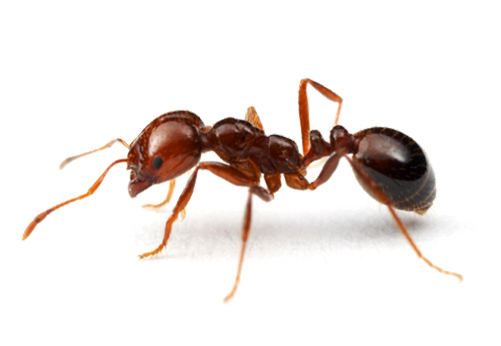Ants
Carpenter Ants
- Carpenter ants nest in moisture-damaged wood
- They forage outdoors for insects and honeydew from aphids
Carpenter Ants-Biology
- Biology of Carpenter Ants; The life cycle of Carpenter Ants begin with the nuptial flight, which occurs in the late spring or early summer, depending on environmental factors. During this mating flight, male winged Carpenter Ants, or swarmer’s, mate with winged females. Soon after mating, the females shed their wings and the males die. The females then search for a new site to build their colonies. The queen typically seeks a small crack in a wooden structure. She then closes herself inside and lays the first batch of eggs. It takes three to six years to establish a large and stable colony. There are two types of Carpenter Ant nests: Parent colonies and Satellite colonies. Parent colonies contain workers, numerous broods and an egg-laying queen. While satellite colonies may have workers, mature larvae and pupae. Any of these nests can become a problem in houses and buildings. The life cycle of a Carpenter Ant is estimated to be between 6-12 weeks from egg to adult. Carpenter Ants may be black, red, brown, tan, yellow, or some combination thereof, depending on the species.
Carpenter Ant-Identification
- Color black, combinations of red and black, or completely bred or brown. Antenna 12 segmented, without a club. Thorax lacks spines, profile evenly rounded on upper side. Pedicel 1-segemented. Gaster with anal opening round, surrounded by circlet of hairs. Stinger absent. Workers capable of emitting a strong formic acid odor.
Carpenter Ant Threat
- Get their common name from their habit of hollowing out galleries in pieces of wood for nesting purposes. This nesting habit can result in structural damage. Although Carpenter Ants do not sting, their bites can be quite painful, especially when they inject formic acid into the wound. They prefer to attack wood softened by fungus and often associated with moisture problems.
Carpenter Ant Infestation
Visible sawdust
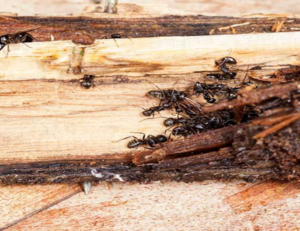
Hallow galleries
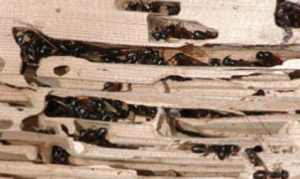
Carpenter Ants inside tree

Carpenter Ants = Bent antennae
Termites = No bend in antennae
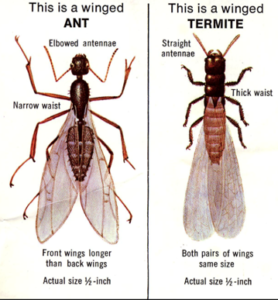
Common Areas to Inspect for Carpenter Ants
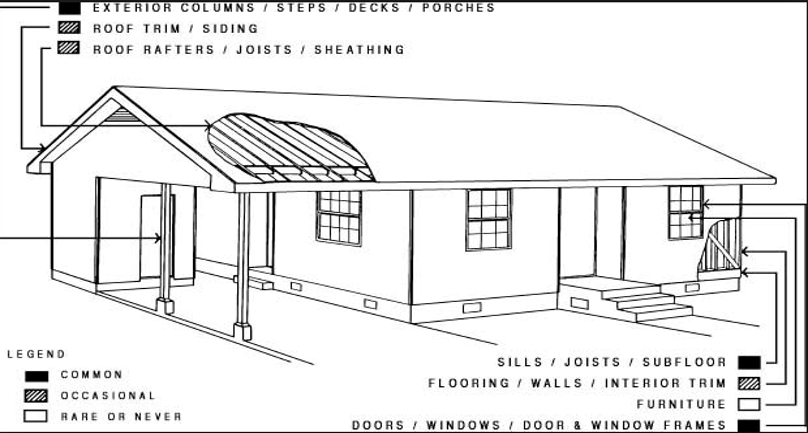
Odorous House Ant
- Odorous house ants often nest near a moisture source in wall voids, behind paneling and baseboards
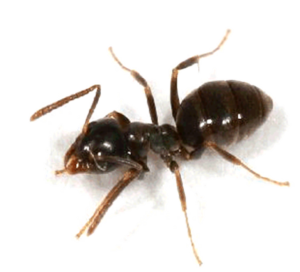
Odorous House Ant-Biology
Biology of Odorous House Ants; Odorous House Ants are approximately 1/8 inch long. Are a black to dark brown body color. Worker ants emit a rotten coconut like odor when crushed. They have one flat node segment, hidden by abdomen. Uneven thorax, no spines. 12- segmented antennae, no club. They often nest in wall crevices, near heaters, water pipes, under carpets, or beneath the floor. They are most likely to invade buildings during rainy weather. Odorous House Ants travel in trails, foraging day and night. They will nest both indoors and outdoors. Outdoors these ants nest beneath soil, logs, mulch beds, and debris and under rocks. Each colony may contain two or more queens with 100,000 workers.
Odorous House Ant- Identification
- Workers about 1/16-1/8” long. Body brown to black. Antenna 12 segmented, without a club. Pedicel 1-segmented, with small node/segment hidden from view from above by base of gaster. Gaster with anal opening slit like, lacking circlet of hairs. Stinger present. Workers emit a disagreeable, rotten, coconut –like odor.
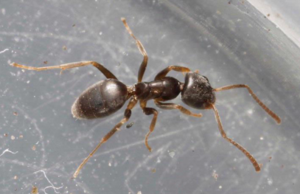
Pharaoh Ant
- Pharaoh ants are active indoors all year
- Nests are in electrical switches and wall voids, and behind baseboards
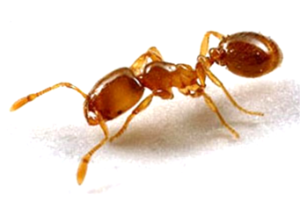
Pharaoh Ants-Biology
Biology of Pharaoh Ants; The Pharaoh Ant queen can lay hundreds of eggs in her lifetime. Most lay 10 to 12 eggs per batch. Eggs hatch in five to seven days. The larval period is 18-19 days. From egg to sexual maturity, it takes about 38-45 days. They breed continuously throughout the year in heated buildings and mating occurs in the nest. Mature colonies contain several queens, winged males, workers, eggs, larvae, pre-pupae and pupae. Pharaoh Ant workers are very small about 1/16 inch long. They are light yellow to reddish brown in color with the abdomen somewhat darker. They have two node segments, uneven thorax with no spines. The antennal segments end in a distinct club with three progressively longer segments. They feed on a wide variety of foods, such as jellies, honey, shortening, peanut butter, corn syrup, fruit juices, baked goods, soft drinks, greases, and dead insects. Also these ants can gnaw tiny holes in silk, rayon, and rubber goods. These ants are capable of mechanically transmitting diseases and contaminating sterile materials. Nests usually occur in wall voids, under floors, behind baseboards, in trash containers, under stones, in linens and light fixtures. They are “trail making” ants.
Pharaoh Ant- Identification
- Workers about 1/16” long. Body usually pale, varying from yellowish to reddish, with abdomen often darker to blackish. Antenna 12 segmented, with 3-segmented club. Thorax lacks spines, profile unevenly rounded. Stinger present. Queens about 1/8” long, with/without wings, and slightly darker in color than workers. Males about 1/16”, winged, black in color, and antenna straight, not elbowed.
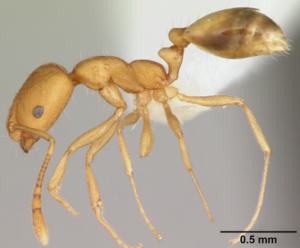
Pharaoh Ant Infestation
Ant battle!
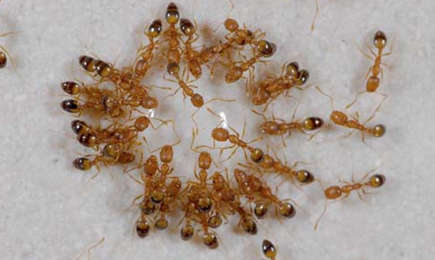
Some Pharaoh ants have wings

Pavement Ant
- Nests are in exposed soil, under stones, and pavement
- Head and thorax have distinct grooves
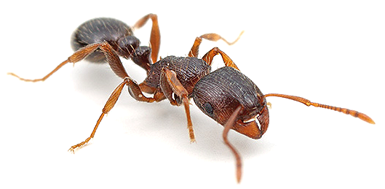
Pavement Ants-Biology
Biology of Pavement Ants; Pavement Ants vary in color from red brown, to blackish-brown. They are approximately 1/8 to ¼ inch long. Colonies have three distinct castes; queen, kings, and workers. The only function of king and queen is to reproduce. All of the workers are sterile females. The workers build the nest, take care of young, and hunt and gather food. The workers are the ones you will find invading homes. They will eat most any food from sweets, starches, greases, meats, fruits and vegetables. Pavement Ants need moisture and will travel some distance to find a source. Pavement Ants usually nest in the ground outdoors under sidewalks, driveways, cracks of pavement, in lawns, and near the foundation of buildings. They can also nest in walls, under floors, and in insulation. They enter home through natural cracks in the slab of foundations.
Pavement Ant- Identification
- Works about 1/16-1/8” long. Body light brown to black with paler legs and antennae. Head and thorax grooved with parallel lines. Antenna 12 segmented, with 3-segmented club. Thorax with pair of small spines on upper back part, profile unevenly rounded. Stinger present. 2 nodded ant. Can have wings.
Pavement Ant Threat
- Pavement Ants will nest in walls, in insulation, and under floors. They often follow pipes that come through slabs for access to upper floors of buildings. They will also go up masonry walls and emerge into false ceilings and then come down into occupied areas below in commercial buildings. Although not aggressive, worker ants can bite & sting.
Pavement Ant Infestation
- In crack of garage floor
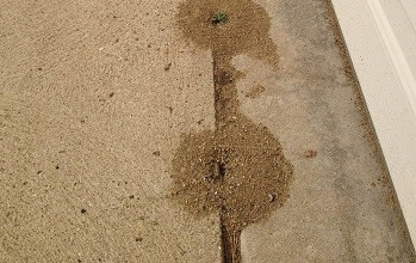
- On sidewalks

Pavement Ant Nests
- Nests openings are crater shaped

Acrobat Ant
- Acrobat ants have a heart-shaped abdomen
- They often nest in moisture-damaged wood
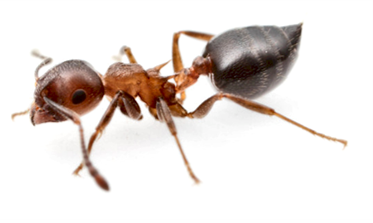
Fire Ant
- Nest are large, above-ground mounds
- When colonies are disturbed workers become aggressive and sting
